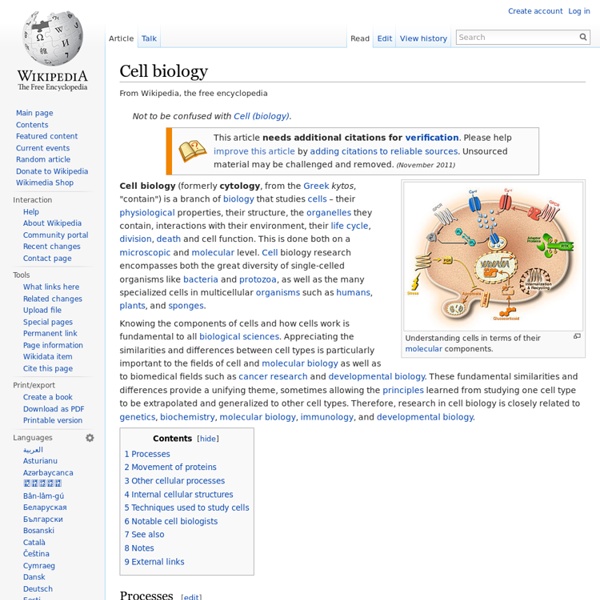Cell biology

Fractal Globules in DNA : FractalFoundation.org
Researchers have discovered how the DNA is packed into our cells in such a way that the roughly 2 meters of DNA in each cell doesn’t tangle, and is easily accessible when it’s needed to make proteins. And the key is: Fractal Geometry! ‘…Researchers found that the genome has a highly organized structure. Fractal folding keeps DNA organized in a cell's nucleus, despite the tight pack. Read more details at Science News.
The Cell and its Organelles
Lists of Nobel Prizes and Laureates The Cell and its Organelles Play the Incredible Megacell Game About the game An ultracentrifuge is used for separating the organelles in the cell according to their size, shape and density. The Nobel Prize The 1974 Nobel Laureates in Physiology or Medicine developed methods that made it possible to see and identify organelles, the specialised compartments inside all our cells.Read More » Share this: Share on facebook Share on google_plusone_share Share on twitter More Sharing Services Share on email To cite this pageMLA style: "The Cell and its Organelles". Recommended: The Legacy of Alfred Nobel On 27 November 1895 Alfred Nobel signed his last will in Paris. Play the Blood Typing Game Try to save some patients and learn about human blood types! Unlocking the Secrets of Our Cells Discover the 2012 awarded research on stem cells and cell signalling. Contact E-mail us Press Sitemap A-Z Index Frequently Asked Questions Terms Follow Contact | Press | Sitemap | FAQ | Terms
Molecular Expressions Cell Biology: Structure of Cells and Viruses
Introduction to Cell and Virus Structure At first glance, the petal of a flower or the skin on the back of a human hand may seem smooth and seamless, as if they were composed of a single, indistinct substance. In reality, however, many tiny individual units called cells make up these objects and almost all other components of plants and animals. The average human body contains over 75 trillion cells, but many life forms exist as single cells that perform all the functions necessary for independent existence. Most cells are far too small to be seen with the naked eye and require the use of high-power optical and electron microscopes for careful examination. The relative scale of biological organisms as well as the useful range of several different detection devices are illustrated in Figure 1. Yet, until the mid-seventeenth century, scientists were unaware that cells even existed. Questions or comments? Last modification: Thursday, May 12, 2005 at 11:18 AM Microscopes provided by:
Scientists discover double meaning in genetic code
Scientists have discovered a second code hiding within DNA. This second code contains information that changes how scientists read the instructions contained in DNA and interpret mutations to make sense of health and disease. High resolutionClick to expand Genome scientist Dr. John Stamatoyannopoulos led a team that discovered a second code hidden in DNA. A research team led by Dr. Read the research paper. The work is part of the Encyclopedia of DNA Elements Project, also known as ENCODE. Since the genetic code was deciphered in the 1960s, scientists have assumed that it was used exclusively to write information about proteins. “For over 40 years we have assumed that DNA changes affecting the genetic code solely impact how proteins are made,” said Stamatoyannopoulos. The genetic code uses a 64-letter alphabet called codons. In addition to Stamatoyannopoulos, the research team included Andrew B. Stephanie H. Tagged with: DNA, ENCODE, genome
Mitochondria Research
Related:
Related:



